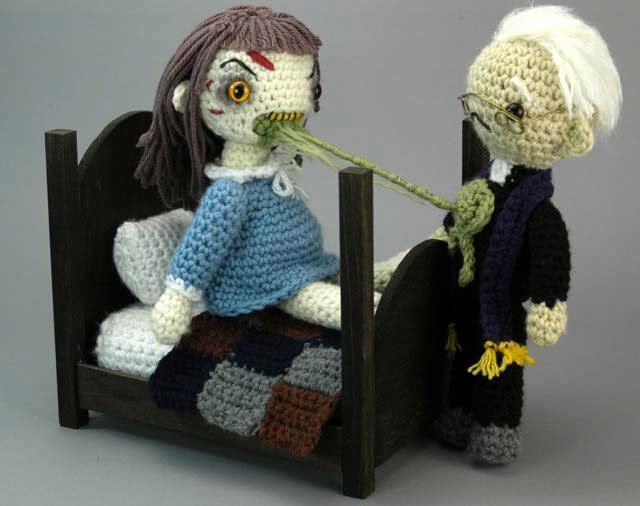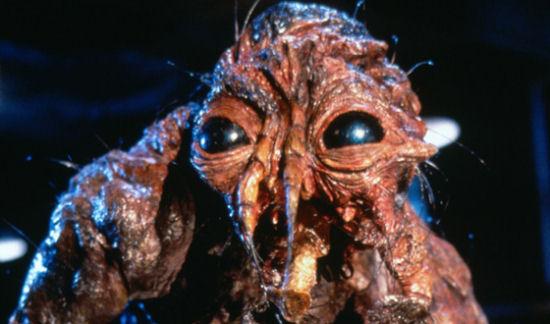Sometimes
when you find yourself stuck in a traffic jam, you eventually
discover that the reason for the slowdown was other drivers' morbid
fascination in someone else's terrible car crash. And whilst you're
shocked to discover the reason, you sometimes can't help but take a
peek yourself. It's human curiosity and it's natural.
The
same experience happens when watching a scary film or horror movie.
You want to look away, but you just can't. You hide behind the sofa
cushions, but you leave just enough room to peek and watch anyway. I
can honestly say that despite my parents' warnings as a child, I
stayed up to watch horror films that were much too adult for my
juvenile brain, but I just couldn't help myself. The more I found
myself disgusted, the more I found myself glued to the television.
 |
| Good God, M. Night, why must you scare me so? |
Since growing up, the fascination has only grown and I keep
terrifying myself to the point of insomnia (mainly due to any film
featuring aliens). So why
do millions of people around the world share my enthusiasm for
scaring the living daylights out of ourselves? Is the appeal due to
these films allowing the audience to safely see their hidden desires
and fears? Has the increase in so-called 'torture porn' helped or
only made things worse?
To
discover the roots of the issue, you first have to analyse the
beginning. Humans have told each other ghost stories and urban myths
since we learned to communicate, so it's little surprise that the
instant we discovered how to create moving images, we used it to show
horror to paying audiences.
 |
| The Crystal Maze's forfeits started taking a dark turn... |
With
the innovation of sound in films, America started creating it's own
'monster movies' such as Dracula, King Kong and The Wolfman. These
creature features now featured the added dimension of grunts, groans
and howls to the ghostly figures on screen, as well as providing
suspenseful and atmospheric music to guide the audience. These films
gave audiences a rare opportunity to see terrifying mythical
creatures for the first time, leading to 80
million people attending the cinema on a weekly basis in 1930, some
65% of the total US population - all
scared out of their minds! The prospect of never-before-seen
monsters is summed up well by a quote from King Kong:
"I
am about to show you the greatest thing your eyes have ever beheld.
He was a King and a God in the world he knew. But now he comes to
civilisation, merely a captive, a show to satisfy your curiosity."
With
the maturing of the audience, so came the adolescence of the horror
films. We evolved from being afraid of The Other, to being afraid of
Ourselves. No film shows this better than William Friedkin's The
Exorcist.
 |
| A PG image for those of you left terrified by real images from this film |
The infamous film tells the story of a young girl
possessed by a demon claiming to be The Devil. During the film,
Regan is transformed into a hideous monster and tries to frighten the
titular exorcist by performing unbelievable actions, such as
levitation, projectile vomiting and turning her head around 360°.
This resulted in several people fainting in the auditoriums
worldwide, outrage surrounding blasphemy and millions and millions of
dollars at the box-office. People came in their droves to see “the
most disgusting and vile film of all time” as they wanted their own
opinion, but also because of the morbid fascination we have with
repulsive things. We inherently desire the need to be frightened and
excited. Many peoples' daily lives provide so little excitement,
that the rush that they feel from such vile and disgusting acts is
invigorating.
This
attraction that we have towards films such as The Exorcist led to
more directors trying to exceed the boundaries of taste and what we
consider the limitations of horror. Following The Exorcist's
success, several films featuring grotesqueries such as The Fly,
Scanners and The Thing became critical and commercial successes. However, the backlash was just around the corner.
 |
| Life... er... found a way |
In 1982, the
Video Recordings Act banned a select number of films that it
considered to be corruptible and dangerous to the public, such as The
Texas Chainsaw Massacre, The Driller Killer and I Spit On Your Grave,
giving them the classification of 'video nasties'. The list was
fraught with inconsistencies, such as most of the films not even
being watched, but being banned due to their titles alone, for
example Apocalypse Now.
Ironically, this censorship only cemented
their place in history, making them notorious in the eyes of the
audience and providing a very convenient list for which people could
aim to watch. Thankfully most of the censorship has since been
repealed, but their legacy still proves that horror film audiences
are attracted to that which is thought to be disgusting and
corruptible.
In
recent years, the genre 'torture-porn' has been thrown around to
label films such as The Human Centipede, the Saw franchise and Eli
Roth's Hostel movies, with many critics discrediting them as purely
for sadists who enjoy watching others suffering through extreme
circumstances; a sign of the decline in horror cinema. However, this
idea of films being based purely on grotesque spectacle can be found
in the early years of film when a film called Freaks was released in
1932.
 |
| A very loose definition of the term 'amazing production' |
Freaks revolves around a murder within a circus' sideshow
performers; the titular 'Freaks' such as a
bearded woman, a little person and a set of Siamese twins. It was
produced purely focussed on benefiting from the pre-millennial
audience's fascination with anything different from themselves, and
resulted in quite a vicious backlash. The film horrified instead of
frightened audiences and quite obviously degraded the actors of the
film, dressing them up in embarrassing costumes and making them
debase themselves, all in the name of entertainment. This shows that
there is a line of decency that even horror film fans can distinguish
and not all films provide the twin thrills of excitement and disgust;
some films just exploit.
However,
most film critics agree that whilst the Western world may be
torturing for entertainment's sake, Asian cinema provides audiences
with films that feature torture for a reason. These films from the
East educate about the human condition, as well as take us on an
emotional and psychological thrill-ride. Films from visionary
directors such Takashi Miike, Shinya Tsukamoto and Park Chan Wook
examine darker parts of the human soul and provide commentary on what
make us who we are.
 |
| One of my favourite cinema villains of all time |
Park Chan Wook's seminal Oldboy shows the extent
a man will go to exact vengeance on those who wronged him, and how
much that man is destroyed in the process. However, Asian
film-makers often don't concern themselves with how audiences react
to the way that their films depict these commentaries, trusting in
the viewer's own judgement of their personal threshold. These films
have since gathered a vast appreciation and admiration, and many
credit their balance between disgust and insight.
So
what is next for horror cinema? Will it follow the current trend of
Hollywood films, with a vast majority being shameless remakes and
pale imitations of the Asian horror films, such as The Ring, The
Grudge and Dark Water? Or will they simply learn from those who have
achieved more, by balancing the audience's thirst for vulgarity with
their desire for respect? Whatever the outcome, it is certain that
cinemagoers will attend in record numbers, ready to be repulsed and
intrigued all over again.

No comments:
Post a Comment